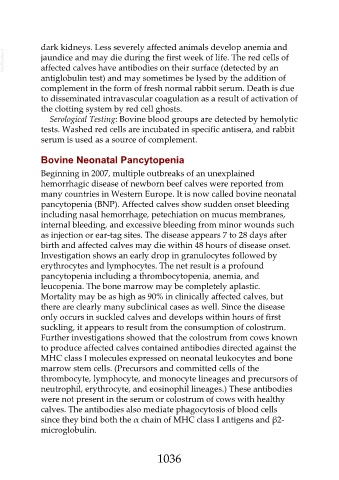Page 1036 - Veterinary Immunology, 10th Edition
P. 1036
dark kidneys. Less severely affected animals develop anemia and
VetBooks.ir jaundice and may die during the first week of life. The red cells of
affected calves have antibodies on their surface (detected by an
antiglobulin test) and may sometimes be lysed by the addition of
complement in the form of fresh normal rabbit serum. Death is due
to disseminated intravascular coagulation as a result of activation of
the clotting system by red cell ghosts.
Serological Testing: Bovine blood groups are detected by hemolytic
tests. Washed red cells are incubated in specific antisera, and rabbit
serum is used as a source of complement.
Bovine Neonatal Pancytopenia
Beginning in 2007, multiple outbreaks of an unexplained
hemorrhagic disease of newborn beef calves were reported from
many countries in Western Europe. It is now called bovine neonatal
pancytopenia (BNP). Affected calves show sudden onset bleeding
including nasal hemorrhage, petechiation on mucus membranes,
internal bleeding, and excessive bleeding from minor wounds such
as injection or ear-tag sites. The disease appears 7 to 28 days after
birth and affected calves may die within 48 hours of disease onset.
Investigation shows an early drop in granulocytes followed by
erythrocytes and lymphocytes. The net result is a profound
pancytopenia including a thrombocytopenia, anemia, and
leucopenia. The bone marrow may be completely aplastic.
Mortality may be as high as 90% in clinically affected calves, but
there are clearly many subclinical cases as well. Since the disease
only occurs in suckled calves and develops within hours of first
suckling, it appears to result from the consumption of colostrum.
Further investigations showed that the colostrum from cows known
to produce affected calves contained antibodies directed against the
MHC class I molecules expressed on neonatal leukocytes and bone
marrow stem cells. (Precursors and committed cells of the
thrombocyte, lymphocyte, and monocyte lineages and precursors of
neutrophil, erythrocyte, and eosinophil lineages.) These antibodies
were not present in the serum or colostrum of cows with healthy
calves. The antibodies also mediate phagocytosis of blood cells
since they bind both the α chain of MHC class I antigens and β2-
microglobulin.
1036

